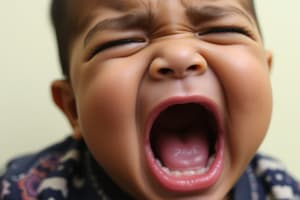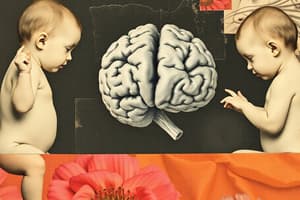Podcast
Questions and Answers
Els nadons neixen amb tots els sistemes corporals complets i funcionals.
Els nadons neixen amb tots els sistemes corporals complets i funcionals.
False (B)
Els nadons tenen la capacitat de sentir dolor des del naixement.
Els nadons tenen la capacitat de sentir dolor des del naixement.
True (A)
L'audició no és un sentit important per al desenvolupament del llenguatge.
L'audició no és un sentit important per al desenvolupament del llenguatge.
False (B)
Quina de les següents opcions és un tipus de moviment que s'aprèn durant la primera infància?
Quina de les següents opcions és un tipus de moviment que s'aprèn durant la primera infància?
Feu correspondre els sentits amb la seva descripció:
Feu correspondre els sentits amb la seva descripció:
Quin és el sistema nerviós que es divideix en central i perifèric?
Quin és el sistema nerviós que es divideix en central i perifèric?
El cervell humà té una plasticitat limitada i no pot canviar en resposta a les experiències.
El cervell humà té una plasticitat limitada i no pot canviar en resposta a les experiències.
El cos callós connecta ambdues hemisferis cerebrals, permetent la comunicació entre els dos.
El cos callós connecta ambdues hemisferis cerebrals, permetent la comunicació entre els dos.
El ______ controla i regula les funcions del nostre cos i ment.
El ______ controla i regula les funcions del nostre cos i ment.
Per què la desaparició de l'aferrament és important per al desenvolupament dels infants?
Per què la desaparició de l'aferrament és important per al desenvolupament dels infants?
El modelatge és important per a l'aprenentatge dels infants, ja que puguin imitar el que veuen a l'entorn.
El modelatge és important per a l'aprenentatge dels infants, ja que puguin imitar el que veuen a l'entorn.
Els infants en edat preescolar són susceptibles a la desnutrició, la qual cosa pot afectar negativament la seva capacitat d'aprendre.
Els infants en edat preescolar són susceptibles a la desnutrició, la qual cosa pot afectar negativament la seva capacitat d'aprendre.
La permanència de l'objecte és la capacitat de comprendre que els objectes existeixen encara que no es veuen.
La permanència de l'objecte és la capacitat de comprendre que els objectes existeixen encara que no es veuen.
Els infants no poden aprendre des de la imitació.
Els infants no poden aprendre des de la imitació.
Segons la teoria de l'aferrament, quin tipus d'aferrament es caracteritza per l'antagonisme entre buscar i evitar la seva cuidadora?
Segons la teoria de l'aferrament, quin tipus d'aferrament es caracteritza per l'antagonisme entre buscar i evitar la seva cuidadora?
La seguretat de l'aferrament té un impacte menor en el desenvolupament emocional i social dels infants.
La seguretat de l'aferrament té un impacte menor en el desenvolupament emocional i social dels infants.
Les emocions, a partir dels 10 mesos, es tornen més complexes i impliquen una consciència del 'jo'.
Les emocions, a partir dels 10 mesos, es tornen més complexes i impliquen una consciència del 'jo'.
En la cultura Maya, les mares no permeten que els seus fills petits tinguin accés als objectes desitjats, perquè volen que aprenguin a compartir.
En la cultura Maya, les mares no permeten que els seus fills petits tinguin accés als objectes desitjats, perquè volen que aprenguin a compartir.
L'autoregulació emocional és un procés ràpid que els infants adquireixen en els primers anys de vida.
L'autoregulació emocional és un procés ràpid que els infants adquireixen en els primers anys de vida.
L'aferrament és un dels factors que condicionen el desenvolupament de personalitat dels infants.
L'aferrament és un dels factors que condicionen el desenvolupament de personalitat dels infants.
La teoria ecològica de Bronfenbrenner considera que el desenvolupament infantil és un producte de la interacció entre els infants i el seu entorn.
La teoria ecològica de Bronfenbrenner considera que el desenvolupament infantil és un producte de la interacció entre els infants i el seu entorn.
El capital social d'una comunitat no té un gran impacte en el desenvolupament dels infants.
El capital social d'una comunitat no té un gran impacte en el desenvolupament dels infants.
La influència dels mitjans en l'aprenentatge dels infants es pot considerar un tema controvertit.
La influència dels mitjans en l'aprenentatge dels infants es pot considerar un tema controvertit.
Flashcards
Sistemes corporals al naixement
Sistemes corporals al naixement
Abans del naixement, la circulació sanguínia, respiració, alimentació, eliminació de residus i regulació de temperatura es realitzen per mitjà del cos de la mare. Després del naixement, tots els sistemes i funcions del bebè han d'operar per si sols.
Cura infantil al món
Cura infantil al món
Les pràctiques de cura infantil i els patrons d’interacció amb els lactants varien en tot el món, depenent de les condicions ambientals, la cultura sobre la naturalesa i les necessitats dels lactants.
Cura infantil segons Pikler
Cura infantil segons Pikler
Una interacció entre l’infant i la persona cuidadora, que tingui influència en el desenvolupament de l’infant. Relació que ajuda a l’infant a connectar amb si mateix, expressar-se, voler explorar i experimentar. No només satisfer les necessitats, sinó ajudar en el seu desenvolupament.
Lactància i primera infància
Lactància i primera infància
Signup and view all the flashcards
Plasticitat del cervell
Plasticitat del cervell
Signup and view all the flashcards
Creixement del cos dels infants
Creixement del cos dels infants
Signup and view all the flashcards
Desenvolupament de cap a peus
Desenvolupament de cap a peus
Signup and view all the flashcards
Desenvolupament de dins cap a fora
Desenvolupament de dins cap a fora
Signup and view all the flashcards
Tacte dels bebès
Tacte dels bebès
Signup and view all the flashcards
Olfacte, gust i audició dels bebès
Olfacte, gust i audició dels bebès
Signup and view all the flashcards
Vista dels bebès
Vista dels bebès
Signup and view all the flashcards
Importància del tacte
Importància del tacte
Signup and view all the flashcards
Anestèsia per a bebès en el passat
Anestèsia per a bebès en el passat
Signup and view all the flashcards
Capacitat dels bebès de sentir dolor
Capacitat dels bebès de sentir dolor
Signup and view all the flashcards
Olfacte dels bebès
Olfacte dels bebès
Signup and view all the flashcards
Relació entre olfacte i gust
Relació entre olfacte i gust
Signup and view all the flashcards
Reconeixement de l'olor de la mare
Reconeixement de l'olor de la mare
Signup and view all the flashcards
Preferències dels bebès pel gust
Preferències dels bebès pel gust
Signup and view all the flashcards
Audició dels bebès al ventre
Audició dels bebès al ventre
Signup and view all the flashcards
Desenvolupament de l'audició dels bebès
Desenvolupament de l'audició dels bebès
Signup and view all the flashcards
Desenvolupament de la vista dels bebès
Desenvolupament de la vista dels bebès
Signup and view all the flashcards
Sentit propioceptiu
Sentit propioceptiu
Signup and view all the flashcards
Sentit de l'equilibri
Sentit de l'equilibri
Signup and view all the flashcards
Plasticitat del cervell en el desenvolupament
Plasticitat del cervell en el desenvolupament
Signup and view all the flashcards
El Sistema Nerviós
El Sistema Nerviós
Signup and view all the flashcards
Funcions de l'encèfal i la medul·la espinal
Funcions de l'encèfal i la medul·la espinal
Signup and view all the flashcards
Components del cervell
Components del cervell
Signup and view all the flashcards
Lateralització del cervell
Lateralització del cervell
Signup and view all the flashcards
Cos callós
Cos callós
Signup and view all the flashcards
Cervell al principi de la vida
Cervell al principi de la vida
Signup and view all the flashcards
Creixement del cervell
Creixement del cervell
Signup and view all the flashcards
Reflexos
Reflexos
Signup and view all the flashcards
Reflexos secundaris
Reflexos secundaris
Signup and view all the flashcards
Plasticitat cerebral
Plasticitat cerebral
Signup and view all the flashcards
Períodes crítics
Períodes crítics
Signup and view all the flashcards
Períodes sensibles
Períodes sensibles
Signup and view all the flashcards
Desenvolupament psicomotor
Desenvolupament psicomotor
Signup and view all the flashcards
Habilitats motores
Habilitats motores
Signup and view all the flashcards
Desenvolupament psicomotor de 0 a 4 mesos
Desenvolupament psicomotor de 0 a 4 mesos
Signup and view all the flashcards
Desenvolupament psicomotor de 4 a 6 mesos
Desenvolupament psicomotor de 4 a 6 mesos
Signup and view all the flashcards
Desenvolupament psicomotor de 6 a 12 mesos
Desenvolupament psicomotor de 6 a 12 mesos
Signup and view all the flashcards
Desenvolupament psicomotor entre 1 i 2 anys
Desenvolupament psicomotor entre 1 i 2 anys
Signup and view all the flashcards
Percepció de la profunditat
Percepció de la profunditat
Signup and view all the flashcards
Precipici visual
Precipici visual
Signup and view all the flashcards
Teoria ecològica dels Gibson
Teoria ecològica dels Gibson
Signup and view all the flashcards
Teoria dels sistemes dinàmics de Thelen
Teoria dels sistemes dinàmics de Thelen
Signup and view all the flashcards
Moviment lliure
Moviment lliure
Signup and view all the flashcards
Influència de l'entorn i la cultura en el desenvolupament motor
Influència de l'entorn i la cultura en el desenvolupament motor
Signup and view all the flashcards
Aprenentatge
Aprenentatge
Signup and view all the flashcards
Consciència
Consciència
Signup and view all the flashcards
Preconscient
Preconscient
Signup and view all the flashcards
Inconscient
Inconscient
Signup and view all the flashcards
La psique
La psique
Signup and view all the flashcards
Enfocament conductista
Enfocament conductista
Signup and view all the flashcards
Condicionament clàssic
Condicionament clàssic
Signup and view all the flashcards
Condicionament operant
Condicionament operant
Signup and view all the flashcards
Enfocament del modelat
Enfocament del modelat
Signup and view all the flashcards
Enfocament psicomètric
Enfocament psicomètric
Signup and view all the flashcards
Enfocament piagetià
Enfocament piagetià
Signup and view all the flashcards
Assimilació i acomodació
Assimilació i acomodació
Signup and view all the flashcards
Etapa sensoriomotora de Piaget
Etapa sensoriomotora de Piaget
Signup and view all the flashcards
Permanència de l'objecte
Permanència de l'objecte
Signup and view all the flashcards
Enfocament del processament de la informació
Enfocament del processament de la informació
Signup and view all the flashcards
Enfocament de la neurociència cognitiva
Enfocament de la neurociència cognitiva
Signup and view all the flashcards
Enfocament sociohistòric cultural
Enfocament sociohistòric cultural
Signup and view all the flashcards
Participació guiada
Participació guiada
Signup and view all the flashcards
Aferrament
Aferrament
Signup and view all the flashcards
Confiança versus desconfiança
Confiança versus desconfiança
Signup and view all the flashcards
Vincle afectiu
Vincle afectiu
Signup and view all the flashcards
Efectes de l'aferrament segur
Efectes de l'aferrament segur
Signup and view all the flashcards
Resiliència dels bebès amb aferrament segur
Resiliència dels bebès amb aferrament segur
Signup and view all the flashcards
Influència del aferrament parental
Influència del aferrament parental
Signup and view all the flashcards
Aprenentatge lingüístic dels bebès
Aprenentatge lingüístic dels bebès
Signup and view all the flashcards
Paper de les famílies i persones cuidadores en el desenvolupament del llenguatge
Paper de les famílies i persones cuidadores en el desenvolupament del llenguatge
Signup and view all the flashcards
Teoria de l'aprenentatge social de Bandura
Teoria de l'aprenentatge social de Bandura
Signup and view all the flashcards
Teoria de Chomsky sobre l'adquisició del llenguatge
Teoria de Chomsky sobre l'adquisició del llenguatge
Signup and view all the flashcards
Study Notes
Development of Personality (0-6 years)
- Physical, Cognitive and Psychosocial Development during the first three years:
- Bodily systems start to operate independently after birth.
- Child-care practices and interactions vary across cultures based on environmental conditions and cultural beliefs.
- These variations and beliefs can significantly influence a child's development.
Infant Care
- Different cultures have diverse perspectives on how to care for infants.
- Cultural beliefs about infants affect the treatment they receive.
- This can range from considering infants as ancestors/gods to not considering them as capable of understanding language.
- Language acquisition and expression is influenced by the language a child interacts with.
- The caregiver's attitude plays a critical role in the infant's development.
Lactation and Early Childhood
- This period begins at birth and ends when infants start walking (between 12-18 months).
- This is a period of increased communication, independence, and mobility.
- The brain's plasticity is high during this time, susceptible to changes based on the environment and interactions.
- Nutrition's importance is stressed during these critical years.
Growth and Nutrition
- Infants are experiencing rapid growth within the first year of life.
- Growth slows down gradually, but continues until the age of three.
Senses and Movement Development
- Development follows two general rules:
- Cephalocaudal: Head to toe.
- Proximal to distal: Center to extremities.
- Senses develop rapidly in the first few months.
- Infants can differentiate various stimuli (sounds, lights, textures) early on.
- Touch is the first sense to develop.
- Infants can feel pain from birth.
- Smell, taste, and hearing develop while the infant is in the womb.
- Sight develops more slowly, but improves significantly within the first six months.
Hearing
- Infants can hear sounds from before they are born.
- They are quickly capable of distinguishing sounds.
- The ability to differentiate and recognize sounds related to language develops quickly.
Vision
- Infants have poor vision at birth but rapidly improve within the first six months.
- Development involves the coordination of both eyes to view a single image.
Smell and Taste
- Infants can detect odors (including their mother's) and flavors.
- Preferences may be established based on the mother's diet during pregnancy.
Brain and Environmental Influences (0-3 Years)
- The baby's brain develops rapidly, reacting strongly to its environment.
- The brain structure mirrors and reacts to the culture of its environment.
- The brain's interconnected network is plastic - readily adaptable based on the environment.
- The central nervous system (CNS) processes information from the environment and controls bodily functions, and is capable of growth and changes.
- The peripheral nervous system (PNS) distributes this information throughout the body.
- The brain's growth is not uniform - some parts grow and develop faster than others.
Primary Reflexes
- Reflexes are automatic, involuntary responses to stimuli.
- Reflexes are present at birth or soon after to support survival and protection.
- They disappear as the brain develops and voluntary control emerges.
- Reflex disappearance indicates appropriate neurodevelopment and brain function.
Brain Development and Environmental Influences (0-3 Years)
- The developing brain is highly responsive to cultural and environmental experiences.
- Infants' responses and interactions influence their brain development, which in turn influences how they react to the world around them.
- Development of the brain includes specialized hemispheres - left and right - that control different functions.
- Early brain development is vital to later brain development due to the brain's plastic nature.
Brain Development: Growth Phases
- Growth spurts, or periods of rapid change in the brain, are essential for early development.
- The brain rapidly develops during the first year, nearly reaching 90% of its adult size by age three.
- Continuous learning and stimulation are vital for optimal brain growth.
Cognitive Development, Language, and Memory
- Understanding how infants develop a sense of self.
- Understanding how infants recognize permanence across time and place.
- How infants develop concepts and use them to explore and react to the environment.
- Early memory development.
- The theory of object permanence.
- The development of memory and problem-solving skills.
- Infants' understanding of their own bodies and how they function in relation to objects.
- Concepts for understanding the environment and its relationships.
Socio-Cultural Influences
- Factors like cultural practices, parenting styles, and socioeconomic status affect how infants develop.
- Children who grow up in environments where they feel safe and accepted learn to interact positively with others, while those in less favourable environments may have difficulty doing so.
- Environmental influences throughout life shape a child's emotional and physical development, as well as their sense of self(identity).
Communication
- Language and communication skills, development of speech and language milestones over development periods.
- How infants use language to interact and understand the world.
- How social expectations influence behaviour and development.
Studying That Suits You
Use AI to generate personalized quizzes and flashcards to suit your learning preferences.




